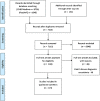Defining and Measuring Diagnostic Uncertainty in Medicine: A Systematic Review
- PMID: 28936618
- PMCID: PMC5756158
- DOI: 10.1007/s11606-017-4164-1
Defining and Measuring Diagnostic Uncertainty in Medicine: A Systematic Review
Abstract
Background: Physicians routinely encounter diagnostic uncertainty in practice. Despite its impact on health care utilization, costs and error, measurement of diagnostic uncertainty is poorly understood. We conducted a systematic review to describe how diagnostic uncertainty is defined and measured in medical practice.
Methods: We searched OVID Medline and PsycINFO databases from inception until May 2017 using a combination of keywords and Medical Subject Headings (MeSH). Additional search strategies included manual review of references identified in the primary search, use of a topic-specific database (AHRQ-PSNet) and expert input. We specifically focused on articles that (1) defined diagnostic uncertainty; (2) conceptualized diagnostic uncertainty in terms of its sources, complexity of its attributes or strategies for managing it; or (3) attempted to measure diagnostic uncertainty.
Key results: We identified 123 articles for full review, none of which defined diagnostic uncertainty. Three attributes of diagnostic uncertainty were relevant for measurement: (1) it is a subjective perception experienced by the clinician; (2) it has the potential to impact diagnostic evaluation-for example, when inappropriately managed, it can lead to diagnostic delays; and (3) it is dynamic in nature, changing with time. Current methods for measuring diagnostic uncertainty in medical practice include: (1) asking clinicians about their perception of uncertainty (surveys and qualitative interviews), (2) evaluating the patient-clinician encounter (such as by reviews of medical records, transcripts of patient-clinician communication and observation), and (3) experimental techniques (patient vignette studies).
Conclusions: The term "diagnostic uncertainty" lacks a clear definition, and there is no comprehensive framework for its measurement in medical practice. Based on review findings, we propose that diagnostic uncertainty be defined as a "subjective perception of an inability to provide an accurate explanation of the patient's health problem." Methodological advancements in measuring diagnostic uncertainty can improve our understanding of diagnostic decision-making and inform interventions to reduce diagnostic errors and overuse of health care resources.
Keywords: definition; diagnostic process; diagnostic uncertainty; measurement; review.
Conflict of interest statement
The authors declare that they have no conflict of interest.
Figures
References
-
- Hatch S. Snowball in a Blizzard: A Physician’s Notes on Uncertainty in Medicine. New York: Basic Books; 2016.
-
- Kennedy AG. Managing uncertainty in diagnostic practice. J Eval Clin Pract. 2015;1356(1294):16. - PubMed
-
- Ghosh AK. Dealing with medical uncertainty: A physician’s perspective. Minn Med. 2004;87(10):48–51. - PubMed
-
- Simpkin AL, Schwartzstein RM. Tolerating uncertainty—the next medical revolution? N Engl J Med. 2016;375(18):1713–15. - PubMed
Publication types
MeSH terms
Grants and funding
LinkOut - more resources
Full Text Sources
Other Literature Sources
Medical


